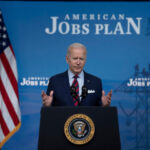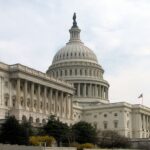By Emel Akan
WASHINGTON— President Joe Biden released on May 28 his budget proposal for next year, which showed a modest economic growth projections over the next decade.
Biden’s $6 trillion budget plan for fiscal year 2022 calls for increased spending on infrastructure, education, childcare, and clean energy. The significant jump in spending reflects his earlier announced infrastructure and social welfare packages—the American Jobs Plan and the American Families Plan.
The budget blueprint predicts a strong rebound from the pandemic-induced recession in the next two years, showing 5.2 percent and 4.3 percent growth rates for the gross domestic product (GDP) in 2021 and 2022, respectively. However, the White House expects the growth to slow down to 1.8 percent or 1.9 percent generally for the rest of the decade before it reaches 2 percent in 2030 and 2031.
A tepid growth outlook for the administration’s “Build Back Better” agenda has disappointed media outlets. They have questioned Biden’s pledge to create “historic economic growth” with his policies.
Politico, for example, in an article called the pace of growth “sluggish” similar to economic performance seen during Obama’s presidency.
Republicans slammed the White House’s budget proposal calling it “the return of the bad old days with slow growth.”
“The Obama-Biden administration famously accepted slow growth as America’s ‘new normal’ while pursuing policies that sent jobs overseas. President Biden appears to be lowering the bar even further,” Republicans on the House Ways and Means Committee said in a blog post.
The budget also proposes a significant increase in borrowing, boosting debt held by the public to over $39 trillion in 2031 from $22 trillion today. And by 2024, debt as a share of the economy would hit an all time record of 113.8 percent, surpassing the World War II-era level.
When questioned about the “tepid” growth projections, White House officials said that projections were developed in early February when the administration “hadn’t fully developed” the infrastructure and welfare packages.
“When we made this forecast, we did include some—we did expect some positive growth effects from some of the investments that we knew we wanted to be able to make,” Council of Economic Advisors chair Cecilia Rouse told reporters during a call on May 28.
When asked to clarify further, Rouse defended the projections of the White House, saying that they exceed the long-term growth forecasts made by the Federal Reserve and the Congressional Budget Office (CBO).
The White House budget projects economic growth would average 1.9 percent in the second half of the decade, compared to CBO’s projection of 1.6 percent and the Fed’s central prediction of 1.8 percent.
According to Rouse, these “seemingly small” differences in growth rate can create “enormous effects on the output and income” that the U.S. economy generates over time.
She said, for example, the difference between the White House’s 2 percent growth forecast and the CBO’s 1.6 percent in 2031, which is a 0.4 percentage point difference in real growth “would translate into the U.S. economy cumulatively producing $4.8 trillion more over a decade in inflation-adjusted 2019 dollars.”
“So that’s roughly $1 trillion more than the annual GDP of Germany,” she added.
Former President Donald Trump’s $4.8 trillion budget proposal last year projected around 3 percent growth over the next decade.
Jason Furman, chair of the Council of Economic Advisers under President Obama defended the growth outlook presented in Biden’s budget proposal.
“I’m glad to see what appears to be a return to responsible economic assumptions in budgeting,” he wrote on Twitter on May 27.
“Most importantly a lot of the benefits of the President’s policies are improving inclusion, opportunity, climate, etc. So even if they didn’t add anything to growth they would still likely be an improvement,” he said.
The president’s budget proposes about $5 trillion of new spending and tax breaks, which would be offset by $3.8 trillion of tax increases and spending reductions.
According to the Committee for a Responsible Federal Budget, the administration’s overall economic assumptions may be too optimistic as it fails to recognize the negative impact of proposed tax increases and borrowing.
The University of Pennsylvania’s Penn Wharton budget model earlier projected that Biden’s infrastructure plan would end up reducing U.S. GDP by 0.8 percent by 2050.
While the business tax hikes decrease government debt over the long term, it would “discourage business investment and thus reduce GDP,” Penn Wharton analysts said.






